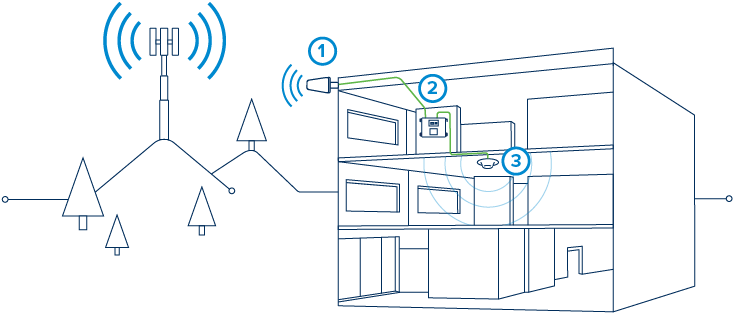Reprinted with permission from the WilsonPRO blog.
Whether you’re a small or large business, opting for a Distributed Antenna System (DAS) is a great way to boost your building’s cellular connectivity. With the necessity for an uninterrupted cell phone signal in the modern digital age, for personal as well as professional reasons, the decision to employ a DAS is an easy one to make, given its enormous benefits.
However, the hard part is choosing the right system (active or passive DAS) and considering the huge variations in the DAS system costs. To top it all, there are quite a few variables when it comes to estimating the overall cost of an active DAS, such as single or multi-carrier option and effective area.
Plus given the high cost of installing an active DAS system, it’s a decision that requires a substantial investment and hence entails careful deliberation. If you’re considering a DAS solution, it would be best to make a careful analysis of your budgetary and connectivity boosting requirements before choosing the perfect fit for your space.
To help you make an informed decision and pick the right system that meets all your needs, we provide a comprehensive guide to the pricing structure for both active and passive DAS. Plus we take a close look at other relevant questions like: Which is the most effective and less time-consuming DAS solution? Which is easier to install? In which situations does it make sense to opt for an active vs. a passive DAS system?
Guide to DAS System Costs
Before diving into the variables involved in choosing and installing the right DAS solution and the comparative DAS system costs for both active and passive solutions, let’s first briefly explore what a DAS system is.
What is a DAS System?
All of us have in some instances experienced poor cellular reception, whether it’s in an enclosed building or an open space. Buildings are typically constructed of materials like concrete, glass, and metal, which can hamper cellular connectivity, causing numerous problems such as dropped calls, disruptions in active calls, and slow or no internet connectivity.
A Distributed Antenna System (DAS) is a cellular connectivity enhancing solution that helps us get rid of the above-mentioned problems. It’s safe to say that DAS is almost a basic requirement today, positively impacting our personal and professional lives.
DAS works by enhancing the cellular signal with the help of installed antennas and other components, helping employees, customers, or tenants enjoy uninterrupted cellular service throughout the building. It can improve connectivity in outdoor as well as indoor spaces, both large and small.
Types of DAS Systems
Typically DAS solutions can be classified into four categories: active, passive, hybrid, and digital. However, since the two most commonly used solutions are active and passive DAS, we’ve limited the scope of this article to these.
Active vs. Passive DAS Cost Comparison Analysis
While both active and passive DAS give superior results, they differ extensively in terms of cost as well as installation requirements, complexity, and time. In a nutshell, passive DAS not only costs a fraction of the overall price of active DAS but is also faster to install and is suitable for a wide variety of commercial establishments.
What is an Active DAS?
An active distributed antenna system (DAS) works by distributing the signal between a centralized signal source and DAS nodes placed remotely around a building. It is a cellular connectivity enhancing solution that provides coverage by creating a cellular signal. Quite understandably then, it has huge deployment requirements and costs.
While it is no doubt a robust solution, active DAS isn’t as widely used as passive DAS, owing to its heavy cost and complex infrastructure requirements. Moreover, its deployment process requires heavy infrastructure, capital, and can be excessively lengthy, taking up to many months or even a year, in some cases. This is because the process is susceptible to delays since it involves a lot of paperwork and requires prior approvals from the concerned carrier(s) and government departments.
Owing to the significant investment in time, money, and infrastructure, opting for an active DAS is only feasible for substantially large spaces like arenas, stadiums, and international airports that get a lot of traffic and typically span more than 250,000 square feet. To get a sense of the coverage area, think of extensive public spaces that attract dense traffic like stadiums or amphitheaters packed with hundreds of thousands of spectators.

How much does an Active DAS system cost?
An active DAS deployment is highly expensive and can amount to millions of dollars. While the Distributed Antenna System cost per square foot ranges between $2 and $4 for a single-carrier solution, a multi-carrier active DAS system starts at $5 and can go as high as $10 per sq. foot. This includes the price of fiber-optic cables, specialized equipment, and deployment.
For instance, for a building that spans 200,000 sq. ft., the deployment costs can range between $400,000 and $800,000 for a single-carrier solution and between $1,000,000 and $2,000,000 for a multi-carrier system.
An active DAS can substantially improve cellular signals by transforming analog signals from carrier networks into a digital signal, while maintaining the original signal strength throughout the building, irrespective of how large it is. There’s no doubt that the active DAS is a high-performing and formidable solution; in fact, installing an active DAS in a building is almost similar to deploying a private cell tower.
But the relevant question is: is it required and more importantly, is it worth the cost for businesses that don’t attract enormous crowds or cover less than 500,000 sq. ft.? Most businesses, large and small, do not require limitless coverage and capacity and can be serviced well with the significantly less expensive but highly effective passive DAS solution.
What is Passive DAS?
A passive DAS or a cell phone signal booster system is the more popular cell signal boosting solution, given its reasonable cost structure coupled with an easy deployment process. It’s the most widely used solution in both commercial as well as residential buildings.
It works by simply bringing inside an outside cellular signal and distributing it throughout the building rather than creating a new signal. It enhances signal coverage and reliability, providing an uninterrupted signal, regardless of where one is positioned in the building. The best part is that unlike most active DAS systems, the passive DAS supports multiple carriers, making it a one-stop solution for all the visitors in your building regardless of their chosen carrier network.

The passive DAS thus preempts the need for creating a multi-carrier solution. Furthermore its hardware and deployment costs are much more affordable in comparison to the active system. What’s more, the systems are also smaller in scope and less disruptive to the existing networks. Most importantly, the installation requirements of a passive DAS are much less demanding and the installation process is significantly simpler and shorter, running into weeks rather than a year (as required for an active DAS).
How much does a Passive DAS system cost?
The passive DAS solution is pocket-friendly, costing approximately between $0.30 and $1 per sq. foot including installation and equipment. Hence, the cost of covering a 200,000 sq. ft. building would range between $60,000 and $200,000,ret all inclusive. Since most commercial buildings in the United States are less than 25,000 sq. ft., the approximate passive DAS cost of covering a building this size is between $7,500 and $25,000.
When should I choose an Active vs. Passive DAS?
A passive DAS system can improve cellular signal reception in indoor spaces ranging up to 500,000 sq. ft. Since most commercial establishments like offices, retail stores, and apartment buildings fall under this category, the passive DAS is highly recommended for most businesses. Another reason that most offices prefer to install a passive DAS is that it conforms to FCC regulations and is carrier approved.
For much larger commercial spaces like stadiums, arenas, and amphitheaters that attract excessively large crowds, it would be best to opt for an active DAS since it increases capacity.
Get in Touch with Solid Signal
All in all, passive DAS is the clear winner thanks to its reasonable costs, lighter equipment, faster and easier installation, and fewer regulations. If you’d like to learn more about WilsonPro passive DAS systems and how it can boost the cell signal in your office, commercial space or warehouse, get in touch with Solid Signal today. Call our commercial experts at 888-233-7563, or fill out the form below.





